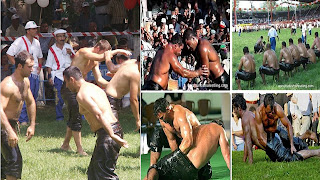Turkish Music
Various aspects of West Asia are summarized in Turkey's music.And, Turkey's music have free rhythms and fixed rhythms.
Instruments of Turkey's music are 'Kamanja', 'Kanun', and 'Saz'.
Instruments of Turkey's music are 'Kamanja', 'Kanun', and 'Saz'.
This is 'Kamanja'.
In Turkey, it is called 'Keman'.
In Turkey, it is called 'Keman'.
The body shape looks like coconut.
Next is 'Kanun'.
How to play this instrument is strum the stringssuch as a 'Geomungo' and 'Gayageum'.
How to play this instrument is strum the stringssuch as a 'Geomungo' and 'Gayageum'.
Geomungo and Gayageum are Korean traditional musical instruments.
And last, this is Saz. It has many names.
It is called 'Baglama', 'Bozuq', and 'Buzuq' etc.
It looks like a guitar.
It is called 'Baglama', 'Bozuq', and 'Buzuq' etc.
It looks like a guitar.
How to play Saz is the same as a guitar.
Also, Military music of Osman Turkey age have an effect on Turkey's music and Europe music after.
The music of Turkey includes diverse elements ranging from Central Asian folk music and has many copies and references of Byzantine music, Greek music, Ottoman music, Persian music, Balkan music, as well as more modern European and American popular music influences.
Turkey is a country on the eastern shore of the Mediterranean Sea, and is a crossroad of cultures from across Europe, North Africa, the Middle East, the Caucasus, and South and Central Asia.
The roots of traditional music in Turkey spans across centuries to a time when the Seljuk Turks colonized Anatolia and Persia in the 11th century and contains elements of both Turkic and pre-Turkic influences. Much of its modern popular music can trace its roots to the emergence in the early 1930s drive for Westernization.
With the assimilation of immigrants from various regions the diversity of musical genres and musical instrumentation also expanded. Turkey has also seen documented folk music and recorded popular music produced in the ethnic styles of Greek, Armenian, Music of Albania, Polish, Azeri and Jewish communities, among others.
Many Turkish cities and towns have vibrant local music scenes which, in turn, support a number of regional musical styles.
Despite this however, western-style pop music lost popularity to arabesque in the late 70s and 80s, with even its greatest proponents Ajda Pekkan and Sezen Aksu falling in status.
It became popular again by the beginning of the 1990s, as a result of an opening economy and society.
With the support of Aksu, the resurging popularity of pop music gave rise to several international Turkish pop stars such as Tarkan and Sertab Erener.
The late 1990s also saw an emergence of underground music producing alternative Turkish rock, electronica, hip-hop, rap and dance music in opposition to the mainstream corporate pop and arabesque genres,
which many believe have become too commercial.
Lee Seulbasenna
The music of Turkey includes diverse elements ranging from Central Asian folk music and has many copies and references of Byzantine music, Greek music, Ottoman music, Persian music, Balkan music, as well as more modern European and American popular music influences.
Turkey is a country on the eastern shore of the Mediterranean Sea, and is a crossroad of cultures from across Europe, North Africa, the Middle East, the Caucasus, and South and Central Asia.
The roots of traditional music in Turkey spans across centuries to a time when the Seljuk Turks colonized Anatolia and Persia in the 11th century and contains elements of both Turkic and pre-Turkic influences. Much of its modern popular music can trace its roots to the emergence in the early 1930s drive for Westernization.
With the assimilation of immigrants from various regions the diversity of musical genres and musical instrumentation also expanded. Turkey has also seen documented folk music and recorded popular music produced in the ethnic styles of Greek, Armenian, Music of Albania, Polish, Azeri and Jewish communities, among others.
Many Turkish cities and towns have vibrant local music scenes which, in turn, support a number of regional musical styles.
Despite this however, western-style pop music lost popularity to arabesque in the late 70s and 80s, with even its greatest proponents Ajda Pekkan and Sezen Aksu falling in status.
It became popular again by the beginning of the 1990s, as a result of an opening economy and society.
With the support of Aksu, the resurging popularity of pop music gave rise to several international Turkish pop stars such as Tarkan and Sertab Erener.
The late 1990s also saw an emergence of underground music producing alternative Turkish rock, electronica, hip-hop, rap and dance music in opposition to the mainstream corporate pop and arabesque genres,
which many believe have become too commercial.
Lee Seulbasenna



































